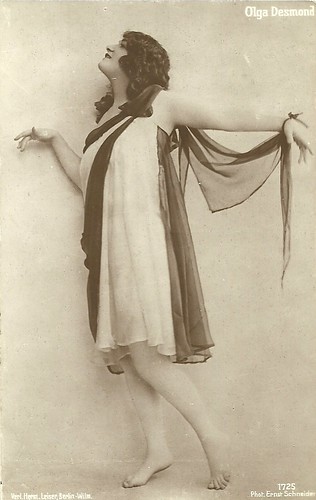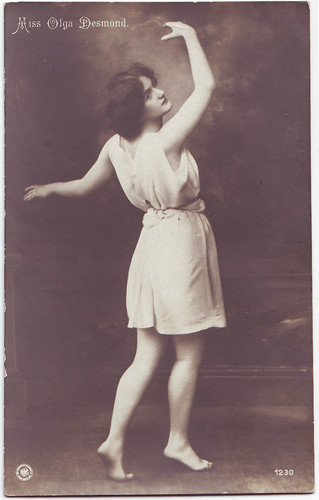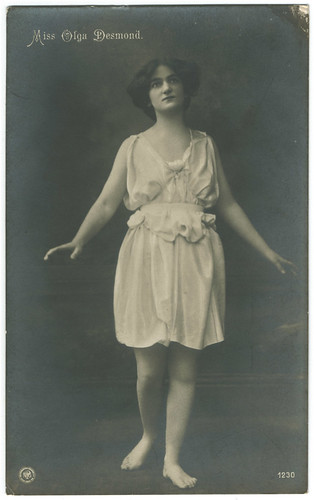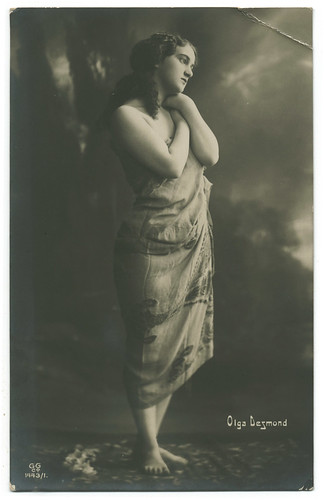Olga Desmond (1890-1964) was a German dancer and actress. Desmond was the 'heroine of living pictures' and became one of the first to promote nudity on the stage. From 1916 through 1919 she appeared in various films.

German postcard by Hermann Leiser, Berlin-Wilm., no 1725. Photo: Ernst Schneider. Collection: Didier Hanson.
Olga Desmond was born Olga Antonie Sellin in Allenstein in East Prussia (now Olsztyn, Poland) 1n 1890. Desmond studied drama and earned her living as a model for artists and painters in Berlin.
In 1907 she joined a group of artists and appeared as Venus during the group's nine-month tour at the London Pavilion where they put on 'plastic representations.' Her dance performances were derived from classical poses and pantomime. She was always dancing barefoot, pretty scandalous for that time, and became most famous for her nude dance performances with special stage make-up.
Back in Berlin she co-founded the Association for Ideal Culture and gave shows called 'living pictures" in which she posed in the manner of ancient classical works of art. These so-called 'Evenings of Beauty' (Schönheitsabende) were prohibited on more than one occasion starting from 1908 because the actors usually posed nude or wearing only bodypaint. She became the 'heroine of living pictures' and she gave guest performances in Great Britain, Austria, the USA and Russia.
In St. Petersburg, Russia, Desmond became one of the first to promote nudity on the stage in the summer of 1908. Desmond’s 'Evenings of Beauty' quickly became the subject of a great debate in the Russian media. At least one of the representatives of official 'justice' wanted to haul Desmond into court for 'seduction.' Desmond herself persistently defended her right to appear naked. "Call it daring or bold, or however you want to describe my appearance on the stage, but this requires art, and it (art) is my only deity, before whom I bow and for which I am prepared to make all possible sacrifices," she told the Russian press, cited on Wikipedia.
"I decided to break the centuries-old heavy chains, created by people. When I go out on stage completely naked, I am not ashamed, I am not embarrassed, because I come out before the public just as I am, loving all that is beautiful and graceful. There was never a case when my appearance before the public evoked any cynical observations or dirty ideas." The authorities in St. Petersburg paid little attention to the explanations offered by the dancer from Berlin, and her first appearance in the imperial Russian capital was also her last: further shows were forbidden by the mayor.

German postcard by Gebr. Garloff, Magdeburg, no. 57270, ca. 1925. Collection: Didier Hanson. Caption: Sascha Naburgow in her performance Plastic Sculptures by famous masters.
Olga Desmond was no less the subject of controversy in her own country. In 1909 her appearance in the Berlin Wintergarten was the cause of such a scandal that it became a subject of discussion even in the Prussian State Assembly. But 'scandalous' also meant 'well-known', and due to her renown, cosmetic products carried her name. One of her performances was filmed in 1909, Hallo! Die grosse Revue: Der Schönheitsabend (1909). She travelled through Germany on numerous tours until 1914, when she married a Hungarian large-landowner, and went off with him to his estate.
From 1915 through 1919 she appeared in various films including Nocturno (Heinrich Bolten-Baeckers, 1915), Seifenblasen/Soap Bubbles (Heinrich Bolten-Baeckers, 1916) with Carl Auen, Postkarten-Modell/Postcard model (Heinrich Bolten-Baeckers, 1917) with Leo Peukert, and Der Mut zur Sünde/Courage for sin (Heinrich Bolten-Baeckers, Robert Leffler, 1918) opposite the later well-known Hans Albers.
In 1917 she separated from her husband and returned to the stage. Her first appearance in 1917 occurred at the Theater der Königlichen Hochschule (Theatre of the Royal University) in Berlin. In the same year, she appeared in a performance of 'Carmen' in Cologne. She presented dance evenings in Warsaw, Breslau (now Wrocław), and Kattowitz (now Katowice).
Thereafter, she made fewer public appearances and from 1922 devoted herself entirely to teaching. Among her best-known students was Hertha Feist, who later became a member of the dance group of Rudolf von Laban. After the First World War, she married her second husband, Georg Piek, a Jewish businessman with a studio for stage equipment, decorations, and special fabrics. After 1933 Piek left Germany.
Olga Desmond continued to manage the business. After World War II, Desmond lived in the eastern part of Berlin. When the wall was built, she was unable to leave. In her late years, forgotten by the public, she worked as a cleaning woman. To make a living, she also sold vintage postcards and other memorabilia from her time as a renowned dancer. Olga Desmond died in 1964 in East Berlin, GDR. She was 73.

German postcard by NPG, no. 1230. Collection: Manuel Palomino Arjona (Flickr).

German postcard by PG, no. 87-5. Collection: Manuel Palomino Arjona (Flickr).

German postcard by NPG, no. 1230. Collection: Manuel Palomino Arjona (Flickr).

German postcard by GG, no. 1443-1. Collection: Manuel Palomino Arjona (Flickr).

German collectors card by Gold Saba in the Series Berühmte Tänzerinnen, no. 90. Collection: Manuel Palomino Arjona (Flickr).
Sources: Thomas Staedeli (Cyranos), Boudoir Cards, Wikipedia and IMDb.
This post was last updated on 31 December 2023.

German postcard by Hermann Leiser, Berlin-Wilm., no 1725. Photo: Ernst Schneider. Collection: Didier Hanson.
Call it daring or bold
Olga Desmond was born Olga Antonie Sellin in Allenstein in East Prussia (now Olsztyn, Poland) 1n 1890. Desmond studied drama and earned her living as a model for artists and painters in Berlin.
In 1907 she joined a group of artists and appeared as Venus during the group's nine-month tour at the London Pavilion where they put on 'plastic representations.' Her dance performances were derived from classical poses and pantomime. She was always dancing barefoot, pretty scandalous for that time, and became most famous for her nude dance performances with special stage make-up.
Back in Berlin she co-founded the Association for Ideal Culture and gave shows called 'living pictures" in which she posed in the manner of ancient classical works of art. These so-called 'Evenings of Beauty' (Schönheitsabende) were prohibited on more than one occasion starting from 1908 because the actors usually posed nude or wearing only bodypaint. She became the 'heroine of living pictures' and she gave guest performances in Great Britain, Austria, the USA and Russia.
In St. Petersburg, Russia, Desmond became one of the first to promote nudity on the stage in the summer of 1908. Desmond’s 'Evenings of Beauty' quickly became the subject of a great debate in the Russian media. At least one of the representatives of official 'justice' wanted to haul Desmond into court for 'seduction.' Desmond herself persistently defended her right to appear naked. "Call it daring or bold, or however you want to describe my appearance on the stage, but this requires art, and it (art) is my only deity, before whom I bow and for which I am prepared to make all possible sacrifices," she told the Russian press, cited on Wikipedia.
"I decided to break the centuries-old heavy chains, created by people. When I go out on stage completely naked, I am not ashamed, I am not embarrassed, because I come out before the public just as I am, loving all that is beautiful and graceful. There was never a case when my appearance before the public evoked any cynical observations or dirty ideas." The authorities in St. Petersburg paid little attention to the explanations offered by the dancer from Berlin, and her first appearance in the imperial Russian capital was also her last: further shows were forbidden by the mayor.

German postcard by Gebr. Garloff, Magdeburg, no. 57270, ca. 1925. Collection: Didier Hanson. Caption: Sascha Naburgow in her performance Plastic Sculptures by famous masters.
Scandalous also meant well-known
Olga Desmond was no less the subject of controversy in her own country. In 1909 her appearance in the Berlin Wintergarten was the cause of such a scandal that it became a subject of discussion even in the Prussian State Assembly. But 'scandalous' also meant 'well-known', and due to her renown, cosmetic products carried her name. One of her performances was filmed in 1909, Hallo! Die grosse Revue: Der Schönheitsabend (1909). She travelled through Germany on numerous tours until 1914, when she married a Hungarian large-landowner, and went off with him to his estate.
From 1915 through 1919 she appeared in various films including Nocturno (Heinrich Bolten-Baeckers, 1915), Seifenblasen/Soap Bubbles (Heinrich Bolten-Baeckers, 1916) with Carl Auen, Postkarten-Modell/Postcard model (Heinrich Bolten-Baeckers, 1917) with Leo Peukert, and Der Mut zur Sünde/Courage for sin (Heinrich Bolten-Baeckers, Robert Leffler, 1918) opposite the later well-known Hans Albers.
In 1917 she separated from her husband and returned to the stage. Her first appearance in 1917 occurred at the Theater der Königlichen Hochschule (Theatre of the Royal University) in Berlin. In the same year, she appeared in a performance of 'Carmen' in Cologne. She presented dance evenings in Warsaw, Breslau (now Wrocław), and Kattowitz (now Katowice).
Thereafter, she made fewer public appearances and from 1922 devoted herself entirely to teaching. Among her best-known students was Hertha Feist, who later became a member of the dance group of Rudolf von Laban. After the First World War, she married her second husband, Georg Piek, a Jewish businessman with a studio for stage equipment, decorations, and special fabrics. After 1933 Piek left Germany.
Olga Desmond continued to manage the business. After World War II, Desmond lived in the eastern part of Berlin. When the wall was built, she was unable to leave. In her late years, forgotten by the public, she worked as a cleaning woman. To make a living, she also sold vintage postcards and other memorabilia from her time as a renowned dancer. Olga Desmond died in 1964 in East Berlin, GDR. She was 73.

German postcard by NPG, no. 1230. Collection: Manuel Palomino Arjona (Flickr).

German postcard by PG, no. 87-5. Collection: Manuel Palomino Arjona (Flickr).

German postcard by NPG, no. 1230. Collection: Manuel Palomino Arjona (Flickr).

German postcard by GG, no. 1443-1. Collection: Manuel Palomino Arjona (Flickr).

German collectors card by Gold Saba in the Series Berühmte Tänzerinnen, no. 90. Collection: Manuel Palomino Arjona (Flickr).
Sources: Thomas Staedeli (Cyranos), Boudoir Cards, Wikipedia and IMDb.
This post was last updated on 31 December 2023.
No comments:
Post a Comment